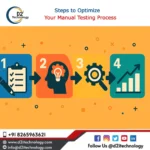- DevOps
- January 15, 2024
- admin
Short Step by Step Guide to a Successful DevOps Implementation

The term DevOps originated by combining two words Development (Dev) and operation (Ops). It describes a way of software creation that integrates testing, development, and operations experts to form a team that is collaborative and also ensures the growth of process automation. In this post on the web, we will discuss the benefits associated with DevOps and the key elements to consider in a DevOps execution strategy.
Benefits of Implementing DevOps
DevOps is rapidly growing in popularity and is proving to be a viable method to enhance and speed up the release of new software/app/app features to the end-user, or client. Because the DevOps method improves the communications between team members within the company and requires an extensive automatization of as many processes as is possible, it offers the following benefits:
- Short time-to-market
- Fewer mistakes and higher quality code
- Improved teamwork and understanding of the processes
- Substantial cost savings
- Easy and effective update of your product
- Recovery and debugging speed is increased.
Stages of the Implementation of DevOps Plan
It is best to begin the DevOps implementation within an extremely short release to reduce risks and test out the efficacy of this method. If the implementation is successful it is easy to expand and utilize DevOps to tackle larger projects. We will now discuss the primary DevOps process steps for implementation.
1. Create a DevOps implementation strategy
Like in all processes of development, a lot must be completed prior to the beginning. These are the aspects we should emphasize:
- Business analysis Examining the market and creating the functional requirements for the future software.
- Branching strategy The method to select the code version to release – uses the branching method.
- Organizing the team According to us, the biggest challenge to DevOps implementation is changing the current corporate culture one that has distinct teams that are working on their particular task and a unified environment where everyone is aware of and recognizes the importance of the different departments, and to implement a system of motivation and team building activities. Every member of the team must be open to continuous communication as they learn and use innovative tools and solutions.
2. The process of development begins.
It’s the perfect time to have software engineers become part of the process of development. The next step is to have meetings as well as the introduction of the use of innovative tools.
- Tools and ArchitectureThere is a requirement to create the app’s design in accordance with the functional requirements, as well as selecting the environment resources that will be utilized such as databases such as messaging systems, cache systems, third-party libraries, and so on. It is also the time to design an approach to disaster recovery and choose the various tools that will be used, from the framework used for the Smoke test (like Cucumber or Selenium) to a CI/CD tool.
- Test-driven developmentBegin coding by beginning to code using the TDD (test-driven development) method. This approach requires that the team develops tests that meet the functional requirements. Only later does it write a program that can be able to pass the tests.
3. Automated provisioning of environments
The goal is to create an application or script that automatically creates and configures the necessary resources required for the various environments including a sandbox (an isolated environment where every engineer is able to test what he desires without impacting the other components in the application) and on to the production.
4. Install Continuous Integration (continuous integration)
Now, we must configure this continuous integration process which will automatically test and compile the code every when a new modification is committed. If the new build is confirmed then the system will release this code to be pushed to be merged into the master branch. Below are examples of the tools you could make use of Jenkins, Bitbucket Pipelines, Bamboo, TeamCity, and so on.
5. Set up CD (continuous delivery)
CD is inextricably tied to CI and the responses to automating the process of pushing tests-approved and tested versions of code to the next environment, from development, to test to production.
6. Containerization
Typically, the application is installed on an individual server or the VM (virtual device). This means that scaling and other changes require considerable effort, and that is why more frequently DevOps engineers utilize containerization which is a method that eases the process of installing the build in the new environment and making adjustments. By storing your code as well as all its dependencies, the container permits your application to run efficiently and effectively in different computing environments. This is the diagram that illustrates the differences between containers and virtual machines.
Continuous deployment and automated testing
Once the code has passed all of the earlier stages, the code should be put through final tests (like tests that mimic users’ behaviors from UI and creating reports). These tests need to be designed and automated. They should also be well-thought and frequently checked to ensure high quality.
Once all tests have been successfully passed after which the build is moved into production. There are two possibilities:
- The code needs to be approved by an authorized person.
- The code is immediately sent into production.
Monitoring performance
Even with sophisticated monitoring tools, it can be difficult to control and monitor every aspect, so the most crucial metrics must be highlighted, for example finding issues with the application or monitoring the health of servers. This will ensure that you receive prompt notifications of any problems, thereby solving them swiftly. Monitoring tools also offer lots of information to analyze, which helps enhance the app, include useful features, scale up the infrastructure when necessary, etc.
Conclusion
As with everything else that makes processes easier and quicker without compromising the quality of service, DevOps will keep gaining popularity. If you’re interested in gaining its advantages as well as getting past the hurdles when implementing DevOps, D2i Technology is here to assist you.
Latest News

Transform Your Business with Top Web Development
June 30, 2025

Steps to Optimize Your Manual Testing Process
June 16, 2025
Category
- Accessibility Services (19)
- Accessibility Testing (6)
- Application Development (5)
- Automation Testing (4)
- CDN Technology (1)
- Developer Tools (5)
- DevOps (28)
- DevOps Consulting Companies (2)
- DevOps Services (2)
- Digital Marketing (5)
- Game Testing (1)
- IT Services (8)
- Manual Testing (6)
- Mobile Development (4)
- Operating Systems (2)
- SecOps (1)
- Security (1)
- Software Development (2)
- Software Quality (2)
- Software Testing Companies (1)
- Testing (1)
- Uncategorized (4)
- Web Application (2)
- Web Designing (3)
- Web Development (6)
- Web Development Companies (6)
- Website Accessibility (16)
- Website Services (3)
- WordPress (2)
